
Torso Wound Care Page Menu: 1 2 3 4 5 6 7 8 9 10 <<First
Torso Wound Care During the Golden Age of Piracy, Page 10
Wounds of the Internal Organs - The Stomach
"The signs of a wound in the jejunum [small intestines] and stomach are the same; for the food drink pass through the wound; the præcordia [upper middle part of the abdomen] grow hard; sometimes bile is vomited. Only it must be observed, that the jejunum is situated lower than the stomach." (Aulus Cornelius Celsus, Of Medicine in Eight Books, 1756, p. 275)
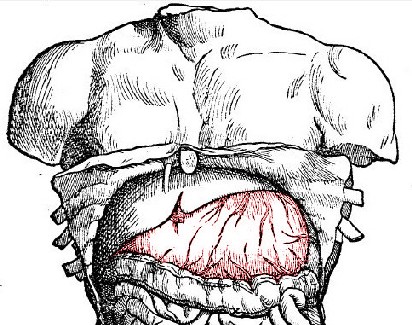
Artist: Andraes Vesalius
Location of Stomach in Abdomen, From De Humani Corporus, p. 561 (1543)
Prognosis: Surgical authors had varying opinions about the survivability of a wound to the stomach. James Cooke reported that when a "Wound happen[s] ...in the Nerves, distributed through the Stomach, 'tis mortal; the other may be cured."1 Matthias Gottfried Purmann provides an essay on wounds of the stomach. He explains that they "are dangerous, and generally mortal, especially if they happen in the [pyloric] Orifice [the gateway between the stomach and the duodenum or first part of the small intestine], or pierce through the lower part or bottom of the Stomach"2. Purmann explains that part of the reason for this danger is that the nerves found here have 'great affinity' with those of the brain and diaphragm. In addition, he points to the fact that food which would normally progress through the intestines can now go into the abdominal cavity "and there cause dangerous and deadly Symptoms."3
Symptoms: Celsus doesn't provide much in the way of symptoms for wounds of the stomach. However, military surgeons Richard Wiseman, Purmann and Cooke all agree with the two he mentions: vomiting and food coming out of the wound.4
Wiseman and Cooke add that bile comes up with food in the vomit.5 They also all say that the wound results in the patient having hiccups.6 Wiseman and Purmann state that the patient experiences cold sweats in stomach wounds7 while
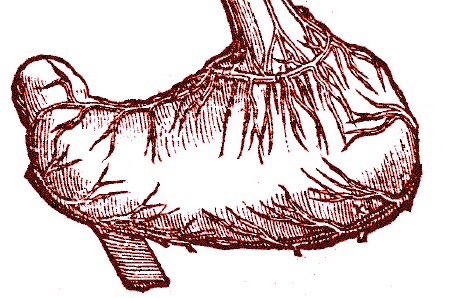
Artist: Andraes Vesalius
The Stomach, From De Humani Corporus, p. 568 (1543)
Purmann alone reports that the patient faints.8
Cure: Purmann says that stomach wounds "are difficult, if not impossible to be cured."9 Nevertheless, James Cooke gives some recommendations for curing them. He starts by advising that they "for the most part are left to cured by Nature; which here and in other internal Wounds doth Miracles."10 He suggests the use of a medicated tent, although he warns the reader not to let it go into the stomach itself. The tent is to be medicated with:
Rx. Ol. Mastic. [oil of mastic resin] Abientin. [probably an oil made from hericium abietis mushrooms] {of each 1 ounce} Man. Thur. [manna thurisera, a type of manna common during this period] {of each 2 drams} pul. Rad. Torment. [powdered root of tormentil, an astringent] Consolid. Major. [powdered comfrey root] {of each 1 dram} Croc. [saffron] {1 scruple} Lumbric. Terr. [oil of earthworms] {1/2 dram} Vin. Alb. [white wine] {2 ounces} coq. ad. Vin. consumpt. [boil until the wine is consumed] f. Liniment. [make into a Liniment]11
1 James Cooke, Mellificium Chirurgiæ: Or, The Marrow of Chiururgery, 1693, p. 134; 2,3 Matthias Gottfried Purmann, Churgia Curiosa, 1706, p. 118; 4 Richard Wiseman, Of Wounds, Severall Chirurgicall Treatises, 1686, p. 432, Purmann, p. 118, Cooke, p. 134; 5 Wiseman, p. 432 & Cooke, p. 134; 6 Wiseman, p. 432, Purmann, p. 118 & Cooke, p. 134; 7 Wiseman, p. 432 & Purmann, p. 118; 8,9 Purmann, p. 118; 10,11 Cooke, p. 135
Wounds of the Internal Organs - The Intestines (Large and Small)
“The signs of a wound in the jejunum [second part of the small intestines] and stomach are the same; for the food drink pass through the wound; the præcordia [upper middle part of the abdomen] grow hard; sometimes bile is vomited. Only it must be observed, that the jejunum is situated lower than the stomach. When the other [large] intestines are wounded, they emit either excrement, or its smell.” (Aulus Cornelius Celsus, Of Medicine in Eight Books, 1756, p. 275)
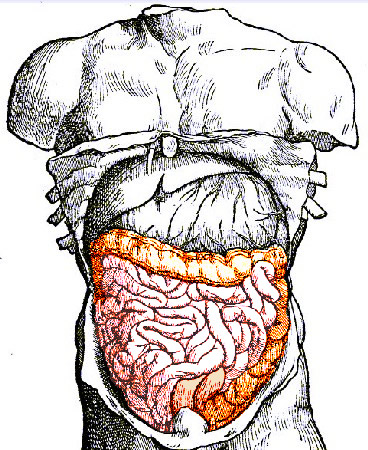
Artist: Andraes Vesalius
Location of Large Intestines (orange) and small intestines (pink)
in Abdomen, From De Humani Corporus, p. 561 (1543)
Surgeons from the golden age of piracy have a lot to say about wounds of the small and large and intestines. In some places, the two are combined and discussed together; in other places they are discussed separately. As a result, they are combined here, separating comments on the small and large intestines where it makes sense.
Prognosis: Most surgeons agree that most wounds of the small intestine can be terminal, yet they note that some of these wounds can be cured. Ambroise Paré specifies that wounds of the jejunum "are deadly; for many vessells run to the Iejunum or empty Gut, and it is of a very nervous and slender substance, and besides it receives the cholerick humor from the bladder of the Gall."1 James Cooke reports that such wounds "are seldom cured"2. Matthias Gottfried Purmann gets more specific, explaining that "if the small Guts are torn and cut cross through, there is no hopes of a Cure; but if the Wound is only in the sides and length-wise" there is a way to cure the wound.3
For wounds of the large intestine, Cooke says that when such wounds "are oft, if livid [dark blue or purple], deadly."4 Purmann disagrees, advising that when "any of the greater Guts are hurt, as the Intestinum Rectum, there is yet hopes of recovering the Patient."5
Symptoms: The symptoms that Celsus mentioned for wounds of the small intestine are shared with those of the stomach. Surgeons from the golden age of piracy did not always follow his lead,
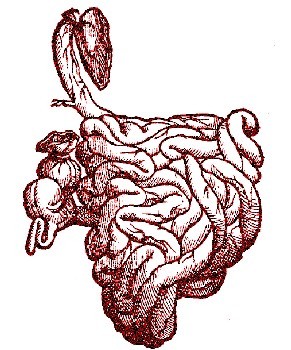
Artist: Andraes Vesalius
Small Intestines, From De Humani Corporus, p. 562 (1543)
indicating other, more particular symptoms for wounds of the small intestines. Like Celsus, everyone mentions the fact that ingested food (and drink) comes out of wounds of the small intestine.6 Richard Wiseman adds that this will occur within half an hour of eating7 and that the substance will be chyle.8 Purmann says the wound will release a mix of chyle and gall.9 They all also agree that vomiting accompanies such wounds, with Wiseman specifying that it will be poracious or greenish. Both he and Paré state that chyle will come up as well.10 Cooke and Paré concur with Celsus that the area will grow hard from swelling.11
Several surgeons mention other symptoms not noted by Celsus, such as the wound being accompanied by 'great', 'grievous' or 'vehement' pain.12 Cooke and Paré both report that the patient will have hiccups and feverish symptoms.13 Paré alone notes that that patient's "extream parts [arms and legs] wax cold."14
All the surgeons discuss symptoms of wounds to the large intestine agree with the one symptom listed by Celsus: they smell like excrement.15 Paré says that "excrements come forth at the wound"16. The ever-detailed Purmann explains "the nearer the Wound is to the Intestinum Rectum, the more Crass is the Excrement. Which are such Demonstrative Diagnosticks, that there is no need to enquire after others."17 Nevertheless, someone does list another symptom. James Cooke explains that "the belly is suppressed"18, suggesting that the digestive and excretory functions cease to function.
Cure: The cure for both small and large intestine wounds is basically the same as that discussed in wounds of the abdomen: restoring anything that he burst forth from the wound back to its place, suturing the wound with a glover's stitch and treating it with medicines. Matthias Purmann and Richard Wiseman both cover
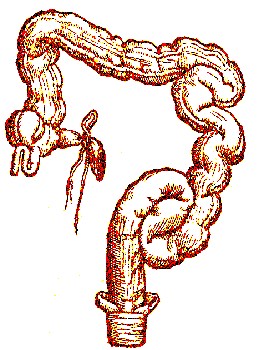
Artist: Andraes Vesalius
The Large Intestine, From De Humani Corporus,
p. 562 (1543)
this procedure, noting that, like other abdominal wounds, it may be necessary to enlarge the wound in the skin to get at the intestines.19 Purmann goes into greater detail for damage to intestines, explaining that the surgeon must "stitch it and put it into its place again"20.
Purmann says a stitched gut is then to be coated in restringent powder, designed to stop the bleeding. He discusses the use of another medicines when stitching the intestines: "if the Gut lies in the hollow part of the Body, then you must draw it towards you, that you may sew it together and put some of my Pulv ad Suturas upon it."21 This literally translates to 'powder for sutures'. This recipe for this medicine,is not specifically denoted in Purmann's book. However, when discussion sutures in cleft pallet surgery, he recommends strewing "fine Powder of Radix Consilida [comfrey root, which is considered adhesive and useful in healing] and Sarchcolla [sarcocolla, a gum that is drying and consolidating] upon them"22. Whether this is his Pulv ad Suturas or not is unclear.
Wiseman takes a different tact, recommending certain medicines for small intestine wounds and others for large intestine wounds. For the small intestines, he advises the surgeon to "embrocate all the Region of the Belly with ol. mastic.[oil of mastic resin] & lumbric.[oil of earthworms] to dress the Wound with Sarcoticks [medicines to unite flesh], and to keep it close and warm with Compress and Bandage."23 These recommendations are in line with those suggested for other wounds of the stomach and abdomen. For wounds in the large intestines, Wiseman suggests that "it may be reasonable to lay open the Wound" with a scalpel or knife to get at the intestine, and sprinkle it with 'Agglutinatives' or medicines to reunite the wound. It is then put back into the abdominal cavity and stitched up.24
1 Ambroise Paré, The Workes of that Famous Chirurgion Ambrose Parey, 1649, pp. 302; 2 James Cooke, Mellificium Chirurgiæ: Or, The Marrow of Chiururgery, 1693, p. 134; 3 Matthias Gottfried Purmann, Churgia Curiosa, 1706, p. 120; 4 Cooke, p. 134; 5 Purmann, p. 120; 6 See Richard Wiseman, Of Wounds, Severall Chirurgicall Treatises, 1686, p. 432, Paré, p. 301, Cooke, p. 134 & Purmann, p. 120, 7 Wiseman, p. 432; 8 Wiseman, p. 372; 9 Purmann, p. 120, 10 Richard Wiseman, Of Wounds, Severall Chirurgicall Treatises, 1686, p. 432, Paré, p. 301-2, Cooke, p. 134 & Purmann, p. 120, 11 Cooke, p. 134, Wiseman, p. 372; & Paré, p. 301; 12 Cooke, p. 134, Purmann, p. 120 & Paré, p. 302; 13 Cooke, p. 134, & Paré, p. 302; 14 Paré, p. 302; 15 Cooke, p. 134, Purmann, p. 120, Wiseman, p. 432; & Paré, p. 302; 16 Paré, p. 302; 17 Purmann, p. 120; 18 Cooke, p. 134; 19 See Purmann, p. 120 & Wiseman, p. 432; 20, 21 Purmann, p. 120; 22 Purmann, p. 20; 23,24 Wiseman, p. 372
Wounds of the Internal Organs - The Spine
“When the spinal marrow is cut through, there follows either a palsy or convulsions; the patient becomes insensible; and after some time, the lower parts discharge involuntarily either feed, or urine, or excrement.” (Aulus Cornelius Celsus, Of Medicine in Eight Books, 1756, p. 275)

Artist: Andraes Vesalius
Spine, From De Humani
Corporus, p. 75 (1543)
The spine isn't technically an internal organ, but, like Celsus, several authors comment on its wounding, so it is presented here.
Prognosis: French military surgeon Ambroise Paré doesn't point to wounds of the spine as being mortal except when the vena cava or aorta (which he calls 'the great artery') are also wounded. Then, "the Patient will dye in a short time, by reason of the sodain and aboundant effusion of the blood and spirits, which intercepts the motion of the Lungs and heart, whence the party dyes suffocated."1 Although he doesn't specifically address the survivability of spinal wounds, English military surgeon James Cooke reported on a case where the back bone was severed. He explains that while he expected the patient to die, "the next morning coming to dress them, I asked if he was dead; but to my amaze[ment], I found him taking a Pipe of Tobaco."2
Symptoms: Paré is the only one to mention the symptoms of wounds to the spine. They agree with those listed by Celsus: palsy and convulsions, "a sodain loss of sense and motion in the parts thereunder, an unvoluntary excretion of the Urine and other excrements, or a totall suppression of them"3.
Cure: Cooke is the only surgeon to discuss the cure of spinal wounds. He explains that when the vertebrae are partially severed, the following medicine should be 'poured in' to the wound:
Rx. Ol. Hyperic [oil of St. John's wort] & de vitel Ovor. [egg yolk] {of each 1 ounce} Tereb. [turpentine] {1/2 dram} Croc. [saffron] {1 scruple} M. [mix together]. After anoint the whole Spine cum Ol. Vulpin.4 [oil of foxes, used in wounds of the nerves] Hirund. [oil of swallows, an odd choice since it is primarily used for epilepsy and problems of the eyes] Lumbric. [oil of earthworms] {of each 1 ounce} M. [mix] The whole back may be embrocated cum Ol. Cham. [Oil of chamomile] {1 ounce} Lumbric. {1/2 ounce} M. [mix].5
In the case of a patient with a severed spine, Cooke uses another, much simpler, medicine and includes more details about the actual treatment. He begin with Liniment Arcei, which was widely used at this time to cleanse and heal wounds, as we have seen in the sections of wounds to the thorax and abdomen. He also applied Paracelsus' Plaster, used to heal dangerous piercing wounds. He then dressed the wound. Returning later, Cooke noted with some surprise, "[a]s soon as the Medicine was removed, we found to admiration, Flesh had filled the Wound, near to the Brim"6.
1 Ambroise Paré, The Workes of that Famous Chirurgion Ambrose Parey, 1649, p. 297; 2 James Cooke, Mellificium Chirurgiæ: Or, The Marrow of Chiururgery, 1693, p. 133; 3 Paré, p. 297; 4 The recipe for this is too bizarre not to include: "Oleum Vulpinum; or Oyl of Foxes. Rx. a Fox at his full growth, and fat, his intrails taken out, and his skin pulled off, and cut into small pieces; of common Salt {3 ounces}, tops of Dill, Thyme, Germander, of each {1 minum} boyl them together in an equal quantity of water and white-wine, till the flesh be separated from the bones; and to {2 pounds} of the Colature [strained liquid], add {4 pounds} of Oyl, Sage, Rosemary, of each {1 minum}, boyl them together, till the water be consumed, then let the Oyle be strained and kept." Jean de Renou, A Medical Dispensatory, 1657, p. 666; 5 Cooke, p. 132; 6 Cooke, p. 133
Wounds of the Internal Organs - The Bladder
"When the bladder is wounded, the groin is pained, there is a tension of the parts immediately above the pubes; instead of urine comes blood; and the urine is discharged at the wound; the stomach is affected, so that the patients either vomit bile, or have a hiccough; a coldness seizes them, and after that death.” (Aulus Cornelius Celsus, Of Medicine in Eight Books, 1756, p. 275-6)
Prognosis: The outlook does not sound very promising for wounds to the bladder based on Celsus'

Artist: Andraes Vesalius
Bladder in Abdomen, From De Humani Corporus,
p. 558 (1543)
description. However, German surgeon Matthias Gottfried Purmann has a different take. Wounds "in the middle or upper part of it [the bladder] are in general Mortal, because the Skin cannot be sewed together, nor can you come at it; but if the Neck of the Bladder or lower in the Flesh part should be wounded, the Cure may be perfected with diligence and proper Medicines."1
James Cooke explains that bladder wounds 'are seldom perfectly cured' because a fistula, or abnormal passage between the bladder and the abdominal cavity usually remains after external healing. However, he finishes his prognosis noting that wounds "in the Neck [of the bladder] are daily cured." 2
Symptoms: As with wounds to the other organs, all of the surgeons copy and build upon Celsus' symptoms. Everyone agrees that there is pain in the groin.3 Richard Wiseman and Ambroise Paré concur that there is tension in the area, with Paré specifically mentioning the thigh muscles.4 They and Matthias Purmann also state that urine comes out of the wound.5 Paré and Cooke agree that there is little normal urination and when it does occur, it is bloody.6

Artist: Andraes Vesalius
The Male Bladder, From De Humani Corporus,
p. 392 (1543)
Purmann adds that in wounds of the bladder "the ordinary place of Passage [of urine] is obstructed, and cannot be made useful but by a Catheter."7
Wiseman adds a symptom to Celsus description: "the Stomach suffers by consent, and the Part wounded demonstrates it."8 Unfortunately, he is not entirely clear about what he means by the wound demonstrating suffering of the stomach.
Cooke adds another symptom not mentioned by Celsus which is rather interesting. "If [the wound is] in the Bottom [of the bladder], Urine Falls into the Belly, procuring a seeming Dropsie"9. Dropsy is a swelling under the skin containing fluid which often happens in the area of the abdomen and groin.
Cure: Since wounds of the bladder are not always considered fatal, some of the surgeons recommend methods for curing such injuries. James Cooke recommends the same medicines as he used to cure wounds of the kidneys. These can be reviewed here. Purmann advises a much broader regimen of treatment:
The Cure much depends upon the Patient’s being kept to a proper Dyet, and that he drinks but moderately and in small quantities. The outward Wound must be Dressed with a good Vulnerary [healing] Balsam, and an Oppodedoch Plaister, and into the Yard [penis] must be injected warm four times a Day, with a Syringe having a long Pipe the following Liquor.
Rx Decoct rad. Altheæ [roots of marshmallow] Alchimill. [roots of ladies mantle, stops bleeding, heals wounds] & veron [veronicae, cleansing and healing]. {3 ounces} aqu. malvæ. Flor borrag. [borage flowers] {of each 4 ounces} Sach. Saturn. [sugar of lead] {2 drams} Laud. opiat. [laudanum pills] {1 scruple} Mell. Chelidon. [honey of celandine] {3 drams} Misce [mix] s. j. detur ad vitr. [let it be given in glass]10
He also recommends giving four ounces of the following potion every morning and evening:
Rx Fol. Agrimon. [agrimony leaves, remove swelling and inflammation] {1/2 handful} herb. fragariæ [strawberries, considered diuretic] auricul. mur. [cerastium fontanum or common mouse ear, healing and astringent] veron. [veronicae, cleansing and healing] sanicul. {of each, one handful} rad. rub. tinct. [root of rubia tinctorum, used in blockages of the organs] serpentar. [snake weed root, diaphoretic] {of each, 1/2 ounce} cort. aurant. [bitter orange peel] {2 drams} cort. Lign. fraxin. [bark of ash tree, diuretic] {2.5 drams} ocul. canc. [crab's eyes] spermat. ceti {of each 2 drams} Misce [mix] f. Decoct. [make into a decoction] cum Aqu. fabar. [with bean water?]11
1 Matthias Gottfried Purmann, Churgia Curiosa, 1706, p. 120; 2 James Cooke, Mellificium Chirurgiæ: Or, The Marrow of Chiururgery, 1693, p. 135; 3 Purmann, Cooke, p. 134, Ambroise Paré, The Workes of that Famous Chirurgion Ambrose Parey, 1649, p. 302 & Richard Wiseman, Of Wounds, Severall Chirurgicall Treatises, 1686, p. 432; 4 Paré, p. 302 & Wiseman, p. 432; 5 Paré, p. 302, Wiseman, p. 432 & Purmann, p. 120; 6 Paré, p. 302, Wiseman, p. 432 & Cooke, p. 134; 7 Purmann, p. 120; 8 Wiseman, p. 432; 9 Cooke, p. 134; 10 Purmann, p. 120-1; 11 Purmann, p. 121
Wounds of the Internal Organs - Conclusion
It is worth noting that all the surgeons who provide detailed diagnosis and treatment for wounds of the internal organs are military, land-based surgeons. Of the three sea surgeons books relevant to this period, only John Woodall had anything to say about such wounds and his comment is essentially that there is little hope of curing them. Because of this, it seems unlikely that surgeons on ships spent much time trying to heal such wounds.

